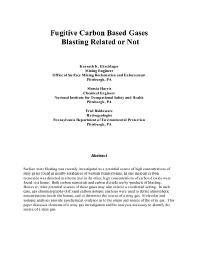 |
Surface mine blasting was recently investigated as a potential source of high concentrations of stray gases found in nearby residences in western Pennsylvania. In one incident, carbon monoxide was detected in a home; in the other, high concentrations of carbon dioxide were found in a home. Both carbon monoxide and carbon dioxide are byproducts of blasting. However, other sources of these gases may also exist in a residential setting. In each case, gas chromatography and carbon isotope analyses were used to define atmospheric concentrations inside the homes and to determine the source of a stray gas. Molecular and isotopic analyses provide geochemical evidence as to the origin and source of the stray gas. This paper discusses elements of a stray gas investigation and the analyses necessary to identify the source of a stray gas.
| Author(s): | Eltschlager-KK, Harris-ML, Baldassare-F |
| Reference: | In: Proceedings of the 30th Annual Conference on Explosives and Blasting Technique (New Orleans, LA, Feb. 1-4, 2004). Vol. 1. Cleveland, OH: International Society of Explosives Engineers; :409-418 |
fcbgbrn (PDF, 347 KB)